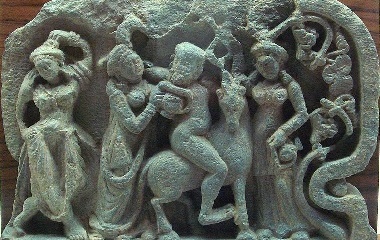What is a Satyr?
Satyrs are the original party animals. These Grecian creatures were born “a tribe of the helpless and worthless,” but they soon found their place in the world: entertaining Dionysus, the god of wine, with their music, dancing, and wild merry-making.
Characteristics
Physical Description
Satyrs are known for their animalistic behavior, and their appearance goes hand-in-hand with their personality.
In early Greek art, Satyrs are part-man and part-horse or donkey. They have heads full of thick curls, beards that fall down to their chests, and nubby horns peeking out of their curly locks. Their noses are short and round while their ears are long and pointed. A horse or donkey tail sprouts from their lower back and sweeps down to the ground.
Some Satyrs varied slightly in appearance. The Panes, for example, had goat legs instead of horse features. The Silenis were thinner and older, with bald heads. And the adorable Satyriskoi were just young boys, lacking the beards and bulging muscles of their older companions.
In late Greek art, Satyrs began to appear even more animalistic. In addition to having a horse’s tail, they began to have horse or goat legs as well. Today’s images are similar—the horsier the better!
Personality
The Satyrs are attendants of Dionysus, the Greek god of wine and celebration, and their rambunctiousness makes them perfect for the role. They revel in wine, music, dancing, and above all else, women. Their parties usually turn into frenzies, since they just can’t seem to control their high spirits. Impulse control simply doesn’t exist among Satyrs.
From a distance, a Satyr party might seem like the place to be, but get too close and you’ll regret heeding their pipes. Satyrs are wild and reckless, a combination that can quickly spin into destruction. They have been known to rip apart villages that stood in the path of their parades, trampling crops, looting food, and generally making a nightmarish mess.
But undoubtedly, Satyrs pose the biggest threat to women. They are famous for their insatiable lust, and they won’t take no for an answer. These muscly, drunken creatures have been responsible for raping countless nymphs, as well as beautiful mortals.
Special Abilities
Still, there is some method to the Satyrs madness. They are extremely talented with musical instruments, and they can produce such hypnotic tunes on their pipes and flutes that other people—and even animals—are forced to join their revelry. Tamborines and brass drums can also be heard in their musical melee. They are also prolific dancers, with some of their dances serving ritualistic purposes that help crops grow or appease the gods.
Cultural Representation
History
Satyrs first appear in Greek literature around the 8th century BCE. Hesiod, Ovid, Strabo, Aesop, Virgil, Cicero, and Nonnus all wrote about the wild parties, brawls, and affairs of the Satyrs. Satyrs are also extremely popular in Athenian red-figure pottery. During the 5th and 6th centuries BCE, countless red-figure designs included Satyrs playing their flutes or manhandling huge wine skins.
Around the 5th century BCE, Satyrs also became extremely popular in theatre. During dramatic plays, a chorus of actors dressed as Satyrs would provide commentary on the drama, often for comic effect. One complete Satyr play, Cyclops by Euripides, still exists today. Fragments of Satyr-plays written by Sophocles and Aesop have also been found.
By the time Satyrs were handed down from the Greeks to the Romans, they had begun to be confused with other party animals. The Romans replaced Satyrs with fauns, woodland creatures with legs like a goat. Fauns carried on the Satyr’s merry-making, but they weren’t quite as robust as their ancestors. They had a more childlike appearance and more connections to nature and wildlife than to agriculture and wine.
Modern Appearances
The spirit of the ancient Satyr lives on in today’s fantasy literature—although they are more commonly referred to by their Roman name, faun.
These musical troublemakers can be found in everything from CS Lewis’s Chronicles of Narnia to Walt Disney’s Fantasia to the role-playing game Dungeons and Dragons.











I want to see a satyr being beaten on live television.
how are they born???
who do they reproduce with
Where do you think baby Satyrs come from.
what do they eat
Women’s sexy parts.
I dont know man thats pretty weird